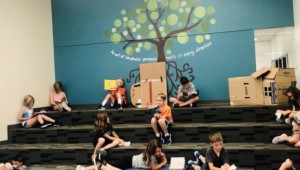K-12 Milestones: What Should Students Know and Be Able to Do and When?

What are the major milestones in K-12 education? The traditional way to answer that question are notable points on academic skill progressions. But given the importance of 21st century skills and an innovation mindset, a sequence of deeper learning experiences is a new way to think about K-12 milestones.
Traditional Academic Milestones
One key milestone often cited is the important third grade transition from learning to read to reading to learn. Another key milestone is high school readiness: a plan and the skills to make the most of those formative years. And, the penultimate goal is graduating college and career ready.
Here’s how Student Achievement Partners describes major work in K-8 math:
- K-2: Addition and subtraction: concepts, skills and problem solving; place value
- 3-5: Multiplication and division of whole numbers and fractions: concepts, skills and problem solving
- 6: Ratios and proportional relationships: early expressions and equations
- 7: Ratios and proportional relationships: arithmetic of rational numbers
- 8: Linear algebra and linear functions
Meredith Liben, Director of Literacy at Student Achievement Partners, said it’s hard to point to discrete literacy milestones with the exception of reading:
- K: Alphabet and phoneme knowledge
- 1: Decoding and moving toward automaticity
- 2: Reading grade appropriate material with fluency (accuracy, expression and appropriate speed)
GreatSchools, known for its comprehensive database of school profiles, developed a series of Milestone videos that describe grade level skill progressions:
First
Second
Third
Fourth
Fifth
Middle School
High School
- Write a great paper and make a great presentation
- Think logically and use models to solve problems
- Manage time and be resourceful
Professional organizations set standards for each content area: NCTM for Math, NCTE for English and NRC for Science. Core Knowledge has a comprehensive content-rich framework of what kids should know by grade level.
Deeper Learning Experiences
While these lists are valuable, it can also be useful to think about the kinds of deeper learning experiences students should have K-8 and high school. These experiences not only result in content mastery, they promote critical thinking, collaboration, effective communication, self-directed learning and an academic mindset.
The following 10 deeper learning experiences (updated from two years ago) provide examples for middle school and high school learners (i.e., by the end of 8th and 12th grade respectively).
1. Postsecondary
- Background: Some students have not benefited from a college bound expectation at home and may not visualize themselves being successful in college. Preparing for a successful postsecondary transition is a complex project requiring self-understanding, research, goal setting and time management.
- Middle School: Make a high school plan designed to prepare for a selective college, chart a rapid and affordable path through a state college or earn a job certificate (TX HB5 is a good state policy example).
- High School: Earn college credit online, from a college instructor in high school, on a college campus (the best option because it helps kids see themselves on a college campus) and/or earn a job certificate.
- Supports: Students should also have the chance to visit several college campuses and be supported in application to several postsecondary institutions; they should have access to several college credit opportunities in high school.
- Beyond: Early high schools create a path to earning an AA degree in high school. YES Prep requires students to gain acceptance to a post secondary pathway. College For America partners with Big Picture Learning to make competency-based AA degrees available to high school students.
2. Careers
- Background: There’s no better way to earn job skills than on the job. Most schools could do a lot more to introduce kids to career options and facilitate work-based learning experiences (see Guiding and Personalizing College & Career Readiness).
- Middle School: Share academic portfolio and begin building a professional profile (e.g., LinkedIn).
- High School: Complete several work-based learning experiences including job shadows and an internship; gain reference letters and add digital portfolio artifacts.
- Options: Check out RoadTripNation and O*Net for resources to explore career options; see NAFtrack for a great example of work readiness certification.
- Beyond: Atudents could create a mobile app, and/or start a business.
3. Community Service
- Background: Service learning and its cousins civics education and democratic schools are gaining popularity and are recapped in this ECS report; 42 states mention service-learning in state policy and 18 states award credit toward graduation for service learning.
- Middle School and High School: Complete an individual and team-based service learning experience; add artifacts and references to digital portfolio.
4. Visual and Performing Arts
- Background: A growing body of research points to the important role of the arts in improving students’ achievement and preparing them for an economy that demands creative solutions to challenging problems. There is also evidence that the arts in education can increase students’ engagement in learning as well as their social and civic development. Many states have an art credit requirement. Schools like High Tech High integrate visual arts and STEM subjects in a compelling way.
- Middle School: Participate in a community performing arts production.
- High School: Present individual artwork to the school community and participate in a group work (performance, choral or visual); add artifacts to digital portfolio.
5. Problem Solving
- Background: In addition to problems that display multivariable problem solving and informed use of probability and statistics, students should experience challenges including design thinking, coding, robotics and maker.
- Middle School: Document completion of a design challenge (see example from Hall Middle School)
- High School: Demonstrate problem solving skills and versatility when faced with three routine and three non-routine challenges; place juried feedback in a digital portfolio (see examples from Harmony Public Schools).
6. Publication
- Background: Young people are inheriting a social many-to-many world. They deserve the digital literacy skills to create and share video, blogs and newsletters. They should also learn when more formal research and writing styles are appropriate.
- Middle School: Produce and share a video and six blogs reflecting on academic
- High School: Prepare and present the findings of an individual research paper (what Harmony Public Schools calls a Level 3 project) and a team publication.
- Beyond: Participation in student newspaper or yearbook. (See feature on Palo Alto High journalism).
7. World Language Fluency
- Background: World language fluency is an important subset of global competency, the ability “to see and understand the world from a perspective other than one’s own, and to understand and appreciate the diversity of societies and cultures.”
- Middle School: Demonstrate basic conversational fluency in a second language.
- High School: Demonstrate global competency which, according to Asia Society, includes the ability to investigate the world, recognized other perspectives, communicate with diverse audiences, and take action to improve conditions.
- Options: Require dual language fluency and teach content areas in world languages.
8. Team
- Background: Nearly all young people will find themselves working on a team. Hewlett Foundation’s Deeper Learning definition adds, “Students cooperate to identify and create solutions to academic, social, vocational and personal challenges.” That also requires that they “communicate and understand multiple points of view and they know how to cooperate to achieve a shared goal.”
- Middle School: Demonstrate a successful team effort including appreciation for factors that create stress or motivate successful performance.
- High School: Document successful contribution to six team efforts demonstrating ability to work with diverse team members and success in different roles, describe how expressing one’s emotions in different situations affects others.
- Option: This requirement could be fulfilled in conjunction with any/all of the others.
9. Project Management
- Background: Management guru Tom Peters said, “What’s normal, on the job or off, will end up being craft, learning, adding value; i.e., the project.” Whether inside a big organization or freelancing, most young people will be managing projects after leaving school. It’s a project-based world. High Tech High, New Tech Network and EL schools require students to manage projects and make frequent presentations of learning
- Middle School: Manage at least six multi-step projects to completion including at least one interdisciplinary project with a public presentation (students at Bulldog Tech in San Jose do at least 100 presentations in two years).
- High School: Demonstrate management of at least a dozen projects to completion including at least two interdisciplinary projects with a public presentations.
- Option: In addition to project management, marketing will prove to be a valuable skill for most students. One projects could be managing a campaign (perhaps a cause-related campaign, running for class office or a sales promotion for a student store).
10. Personal Wellness
- Background: Sports teams and clubs help some youth develop a healthy habits and positive team experiences but in big schools that’s a small percentage of students. In addition to fitness, wellness includes healthy eating and living habits. Students that are doing well, feel happy and sustain healthy connections to families and communities bring that lens to their work in their 20s and beyond.
- Middle School: Demonstrate healthy nutrition and fitness habits.
- High School: Demonstrate a sustained fitness routine as well as healthy living habits.
- Options: Nexus Academy students have a personal trainer. They “develop a personal fitness plan for each student and lead small-group sessions in a variety of activities suited for all fitness levels.” Trainers “instruct students in the value of healthy nutrition, sleep and exercise, and they provide personal attention so students can set and reach individual physical goals.” Quantified self apps are making it easier to track progress on multiple fronts.
Deeper learning experiences develop the mindsets, learning strategies, self-management skills and social skills necessary to be career ready. The American School Counselor Association organized these characteristics into 35 Mindsets and Behaviors for Student Success. Regular reflection and feedback helps students develop and document the ability to manage themselves, to create productive relationships and to make good decisions. (See a discussion of schools where students receive regular feedback on success skills.)
If we work with young people to co-construct compelling experiences, like those above, while providing feedback on discrete skills, as suggested by counselors, more students will graduate ready for a project-based world.
For more, see:
- How to Prepare Globally Competent Students
- Preparing Students for Careers & Developing a Workforce
- Getting Smart Podcast | Project-Based Learning Connects Real World with Deep Impact
Stay in-the-know with all things EdTech and innovations in learning by signing up to receive the weekly Smart Update. This post includes mentions of a Getting Smart partner. For a full list of partners, affiliate organizations and all other disclosures please see our Partner page.








Tom Vander Ark
I'm a fan of personalized learning over the age cohort model but there is something to be said for a community that appreciates the stages of life we all go through. In his new book, 100 Years, Joshua Prager lists literary quotations for every age from birth to one hundred, revealing the hidden patterns of life. See his TED talk http://www.npr.org/2016/06/10/481291161/what-can-great-writers-teach-us-about-growing-up-and-getting-old